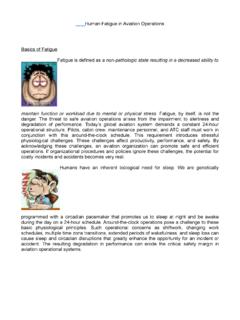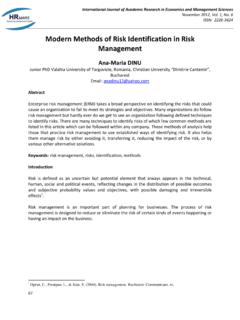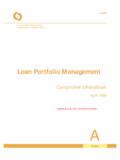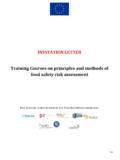Transcription of the state in which the risk to harm to persons or damage ...
1 SMS for Aviation OrganizationsSafety management System (SMS) programs have recently been developed and implemented by airlines, airports, manufacturers, civil aviation authorities, and air traffic control units worldwide. The International Civil Aviation Organization (ICAO) has emphasized SMS implementation with the requirement that by January of 2009, all airlines, ATC providers, aviation maintenance organizations (AMOs) and airports implement an SMS program. The FAA is also developing SMS regulations, with an advanced Notice of Proposed Rulemaking (NPRM) having already been issued in 2009. A description of SMS, safety factors specific to aviation organizations, and requirements/solutions for SMS program implementation follows.
2 Aviation safety management doctrine has shifted from an outdated traditional reactive basis to a modern proactive, organizational-based focus. Aircraft accidents have become statistically rare events. That does not mean, however, that there is no room for improvement. SMS employs advanced system management theory and practice to drive the occurrence rate of serious safety events down to an even lower level. A definition of safety must be provided to grasp the fundamental concepts of SMS. Safety can be defined as the state in which the risk to harm to persons or damage to property is reduced to, and maintained at or below, an acceptable level through a continuing process of hazard identification and risk management .
3 The terms hazard and risk also need to be defined. Hazard is the condition or circumstance that can lead to physical injury or damage and risk is the consequence of a hazard measured in terms of likelihood and severity. SMS is a systematic and comprehensive process for the proactive management of safety risks that integrates the management of operations and technical systems with financial and human resource management . Note that the preceding definition stresses the systems aspect of SMS as its core operational concept. A system can be thought of as a group of processes that act together to transform inputs into a desired output. A system has a clear objective and processes to achieve that objective. A means of measuring the degree to which the objective has been achieved is also necessary to evaluate system performance.
4 The definition stresses that an SMS is a comprehensive process, it includes all aspects of the operation. SMS uses proven procedures and techniques to identify and analyze hazards, and their associated risks , inherent to the operation. The hazards are then eliminated, if possible. If not, the associated risks are managed to a level as low as reasonably practicable by reducing the likelihood of an occurrence or the severity outcome of an occurrence, should one happen. Tracking of the risk mitigation efforts is done to analyze system effectiveness. Concurrent with these efforts, new emerging hazards, and/or hazards initially overlooked, are identified for attention. These efforts are all conducted within a structured framework of safety targets, policies, procedures, and departmental/personnel accountabilities.
5 SMS is comprised of essentially four components: Safety Policy, Safety Risk Assessment, Safety Assurance, and Safety Promotion. Safety Policy establishes senior management 's commitment to continually improve safety. This commitment defines the methods, processes, and organizational structure needed to meet the required safety goals. Safety Risk management determines the need for new or revised risk controls based upon what the organization considers an acceptable level of risk to be. This component also evaluates existing risk control measures. Safety Assurance serves to evaluate (measure) the effectiveness of the risk control strategies that have been implemented, along with the identification of developing hazards.
6 Safety Promotion consists of training, communication, and all other associated initiatives necessary to create and maintain a positive safety culture in the organization. The preceding is simply an overview of SMS, many resources are available that provide a much more in-depth knowledge of SMS design, implementation, and organizations that have adopted an SMS program have realized that the program does indeed add to the bottom line of the company. Aviation organizations exist to deliver a service, achieve production output, and generate return on investment to allow growth and continued operations. In spite of the often-stated phrase that safety is #1 around here , in reality, generation of revenue is what allows an organization to keep its doors open.
7 No aviation organization has ever been created to deliver only safety. Indeed, safety truly is not the first priority for aviation organizations. Effective safety management is just one of many organizational processes that allow a firm to deliver its services and generate profits. Through positive management of safety, SMS programs have become good business operational practice. SMS stands alongside any other core business management function. In today s litigious society, the cost of even one serious aviation safety event can be staggering. A high profile accident has the potential to end the very existence of the company. Resources intelligently allocated to an SMS can ensure the survival of the organization and continued operation of the firm.
8 Organizational factors also introduce hazards. Smaller organizations may not have sufficient resources to employ a full-time safety manager. Safety duties are often assigned as a collateral function to a mid-level manager, such as the Chief Pilot or Manager of Standards. Safety management can unintentionally become a secondary priority, especially considering the substantial effort required. A small company may therefore possess a weak safety culture. The firm must have genuine commitment from upper level management to allocate both personnel and financial resources to the critical functions of safety management . A robust and extensive SMS program can serve as a force multiplier for just such a situation by enabling positive and measurable results to be generated due to the inherent advantages of SMS program requires that the interrelated topics of requirements and solutions be addressed.
9 Successful SMS operation relies on five key concepts: upper level management buy-in, a just culture, safety event reporting and feedback, training and education, and program ownership. Upper level management absolutely must both support and interact with the SMS program. The entire organization must see management not just giving the appearance of promoting the SMS program, but also actually being involved with it. Considering the many demands upon upper level management , this critical requirement is an extreme challenge for an organization. A non-punitive just culture towards affected personnel is also crucial. A single instance of punishment inappropriately applied can destroy the entire initiative.
10 Of course, an organization must precisely define the limits of what is acceptable behavior, such as typical human factors-related events (slips, errors, mistakes) as opposed to willful deviations from policies and procedures (violations, work-arounds , intentional disregard of SOPs). Safety event reporting is a key foundation of SMS. If safety personnel are not informed of event occurrences, there can be no investigations. Training on program basics, implementation, and continued operation is essential. All personnel, from senior management to new-hires, must receive understandable and documented SMS training. This training must be tailored to the personnel receiving it.








